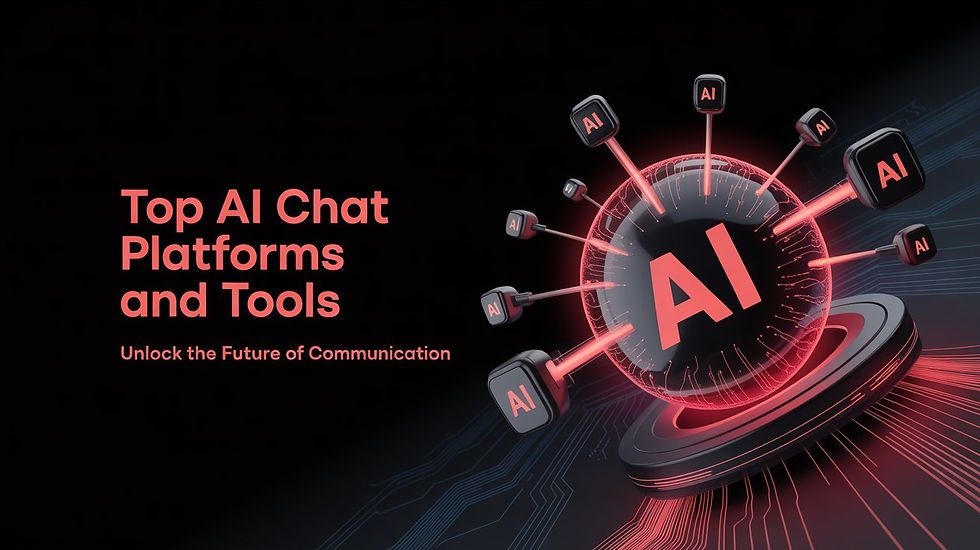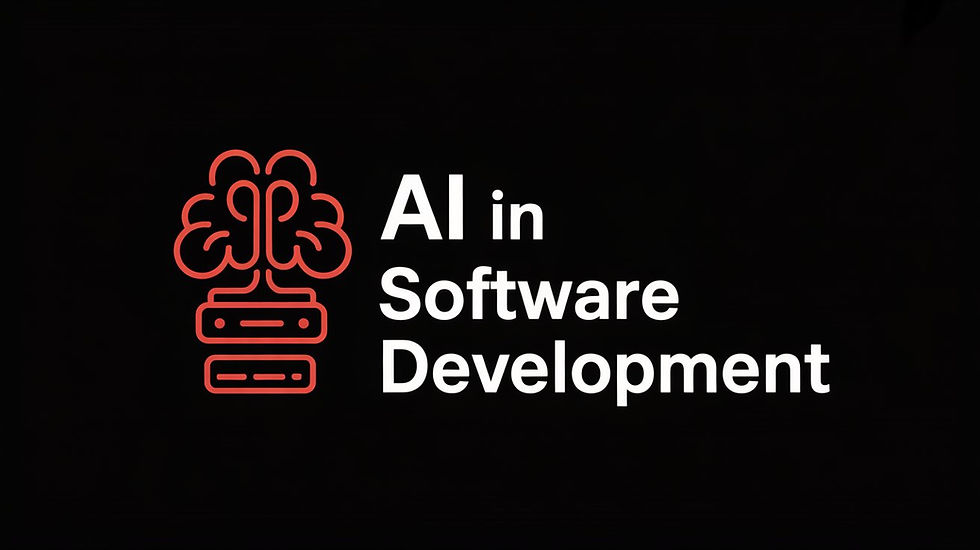AI Agents vs Agentic AI: Definitions, Differences, and Use Cases
- pengarhehe
- Aug 17
- 6 min read

AI Agents vs Agentic AI
AI agents are autonomous software entities that use AI (often large language models) to perceive their environment, plan actions, and execute tasks on behalf of users. In practice, an AI agent “acts like an intelligent worker”: it takes a high-level goal from a human and figures out how to achieve it through reasoning, planning, and tool use. Key features include autonomy (operating without constant prompts), goal-driven behavior, and a loop of perceive–plan–act–learn. For example, an AI email assistant might gather user data, draft a message, send it via an API, and learn from the response all on its own. AI Automation Spot’s guide notes: “AI agents are software systems that use AI to pursue goals and complete tasks on behalf of users,” featuring reasoning, planning, memory, and autonomy. In short, AI agents extend generative models into action by breaking down goals into steps, using tools or APIs to carry them out, and adapting as they go. (See our internal guide [What Is an AI Agent?] for more.)
Agentic AI is a broader paradigm built on AI agents. An agentic AI system consists of one or more autonomous AI agents working together (often coordinated by an orchestration layer) to achieve complex, multi-step goals with minimal human supervision. In agentic systems, the agents reason, plan, execute, and adapt as a team. Agentic AI “uses sophisticated reasoning and iterative planning to solve multi-step problems on its own,” essentially marrying generative AI with goal-driven workflows. For instance, instead of just generating a travel itinerary, an agentic AI could write the itinerary, then automatically book flights and hotels using APIs, all without further human commands. AWS explains “agentic AI” as an autonomous AI system that acts independently to achieve predetermined goals, making decisions and adapting without constant human guidance. The rise of agentic AI reflects a shift from passive, one-off tasks (like simple chatbots) to active, self-improving systems that can manage entire workflows end-to-end.

Key Differences Between AI Agents and Agentic AI
While AI agents and agentic AI share many principles (autonomy, planning, tool use), they differ in scope and complexity. The main distinctions are:
Autonomy & Decision-Making: AI agents operate within defined rules or models – they respond to inputs and carry out tasks they are programmed or trained for. In contrast, agentic AI exhibits higher autonomy, capable of proactively setting its own objectives and making strategic decisions without explicit prompts. In other words, an AI agent is reactive (it waits for triggers), whereas agentic AI is proactive. For example, a banking chatbot (AI agent) might wait for a user question, but an agentic system could monitor transactions, detect fraud signals, and initiate investigations on its own.
Task Complexity: AI agents are often specialized for specific, bounded tasks (like scheduling meetings or answering FAQs). They excel at repetitive, well-defined workflows. Agentic AI, however, handles complex, multi-step processes that span domains. It can decompose a big goal into subtasks across multiple agents, coordinating them end-to-end. For example, an IT support agent (traditional) might only classify tickets, but an agentic IT system might take tickets, search knowledge bases, route issues, and even deploy fixes – managing the whole workflow.
Learning & Adaptation: Individual AI agents typically have limited learning within a narrow scope; they may improve through retraining or small updates. Agentic AI systems learn continuously across interactions, adapting their strategies over time. As one guide notes, agentic AI learns from experience and feedback, refining goals and plans in real-time. For instance, a sales agent might personalize responses based on past data, but an agentic marketing AI could analyze campaign results and autonomously adjust targeting strategies without human input.
Proactiveness: AI agents are largely reactive: they act when triggered by user input or a predefined event. Agentic AI is proactive, scanning its environment for opportunities and problems. For example, as AWS explains, an agentic AI system could monitor supply chain data and reroute shipments automatically if delays are predicted.
Integration & Scale: An AI agent often functions as a standalone tool or component in a larger system. In contrast, agentic AI integrates multiple agents (and possibly traditional tools) to tackle overarching objectives. An orchestrator agent might coordinate specialized agents for data extraction, analysis, and action, enabling huge workflows that single agents alone cannot manage. For instance, an agentic AI system in marketing could simultaneously run content generation, ad optimization, and analytics agents to drive a campaign automatically.
In summary, AI agents are the building blocks (autonomous workers for specific tasks), while agentic AI is the full system orchestration of one or more agents. Agents handle defined subtasks; agentic AI connects them to achieve big-picture goals.
Real-World Examples & Use Cases
AI agents and agentic AI are emerging in many domains. Simple AI agents include chatbots, voice assistants (e.g., Siri), and scheduling bots that carry out tasks step-by-step as directed. For example, an AI chatbot agent might answer customer queries using a knowledge base, or a sales agent might draft and send emails when triggered. These agents improve specific workflows but still rely on human direction for overall strategy.
Agentic AI is used when tasks require coordination across steps or channels. In enterprise marketing, for example, AgentC (by Knotch) is a managed AI service built on agentic AI principles. AgentC combines “agentic AI and human expertise to optimize content, media, journeys and growth”. After marketers input data and goals, AgentC’s system of agents can plan a content strategy, generate copy, schedule ads, and analyze performance – all autonomously coordinating among agents. This highlights how agentic AI transforms marketing workflows end-to-end.
Other agentic use cases include customer support automation: an agentic AI system can understand a help request (via an NLP agent), query a knowledge base (via a search agent), decide on a solution (via a reasoning agent), and then either fix the issue or forward it to a human – adapting as needed. In supply chain and operations, agentic AI can monitor data (inventory, weather, demand), make logistical decisions, and adjust schedules on the fly. In IT and RPA, agentic automation (sometimes called agentic RPA) takes traditional bots further: instead of fixed scripts, agentic systems re-plan workflows dynamically (e.g. re-routing a shipment when delays occur).
In short, AI agents automate individual tasks, while agentic AI orchestrates entire processes. Companies applying AI agents might streamline a single function (like chat or email), whereas agentic AI aims to transform business operations by linking AI-powered tasks end-to-end.

Tools, Platforms, and Resources
Implementing AI agents and agentic AI often involves a mix of specialized tools. For instance, marketing teams can use AI-powered platforms like AWeber or GetResponse to automate email campaigns, while content teams might leverage copywriting assistants like Writesonic or Scalenut. Customer support can be augmented with chat platforms like LiveChat or Chatbot.com. For SEO and analytics, tools like SERanking help generate keywords and optimize content with AI insights. On the development side, RPA and workflow tools such as UiPath (with AI Document Understanding) and Make.com provide low-code ways to deploy automated agents.
These tools illustrate how businesses start small (automating emails or copy) and can build up toward more agentic systems. For example, combining an AI writing tool with an email automation platform and a scheduling API essentially creates a simple agent. As companies scale, they may integrate multiple such tools under a unified orchestration layer – the hallmark of agentic AI.
Regardless of specific products, the key is to design systems where AI agents (using LLMs, vision models, etc.) plug into workflows. Emphasizing memory, planning, and tool integration is critical. To learn more about agentic AI implementation and optimization, see AI Automation Spot’s guide on [Agentic AI Optimization], and the foundational [What Is Agentic AI?] article. For practitioners, Google Cloud’s AI Agents documentation and AWS’s Agentic AI whitepapers (cited above) are valuable references.
Conclusion
AI agents and agentic AI represent two related but distinct levels of autonomous AI. AI agents are specialist tools that automate tasks with intelligence and some adaptability, whereas agentic AI is an overarching system where multiple agents work together toward broader goals. Understanding their differences is crucial: choose AI agents for efficient task automation and narrow use cases, and turn to agentic AI when you need cross-functional, goal-oriented automation. As one expert notes, using the wrong approach could lead to an incomplete solution or missed opportunities. By combining both – embedding autonomous AI agents into orchestrated agentic systems – organizations can unlock powerful, scalable automation.





Comments